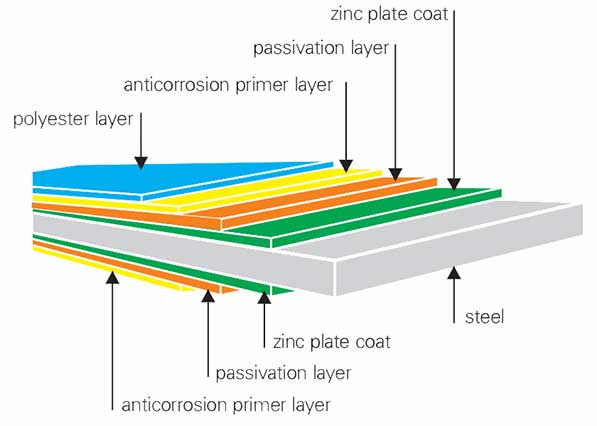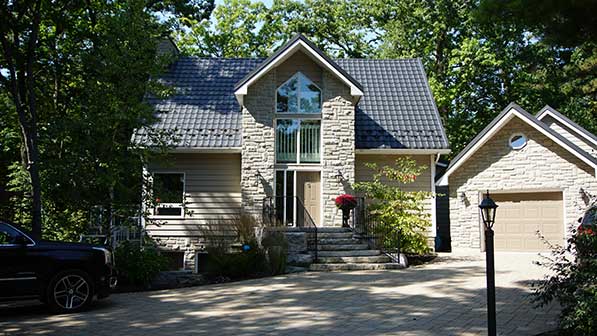Myth: Steel Roofs Rust Easily
Reality: Modern steel roofs are designed to resist rust. Unlike old metal roofs that developed a red rust patina, contemporary steel roofing benefits from advanced protective coatings. Options like aluminum, stainless steel, and copper, as well as insulated metal panels, offer durable, rust-resistant solutions. These coatings ensure that a well-maintained steel roof can last over half a century. Protective paint systems further enhance corrosion resistance.
Zinc-Plated and Primed: Steel roof panels are zinc-plated on both sides and include multiple protective layers such as an anti-corrosion primer, passivation layer, and a polyester paint coat, ensuring long-term durability. This multi-layered approach is crucial in combating the elements and preventing rust from taking hold.

Aluminum Advantage: For coastal regions, aluminum roofing is particularly beneficial due to its superior resistance to salt-induced corrosion compared to steel. Additionally, aluminum’s corrosion manifests as a white rust that blends with most roofing materials, avoiding the conspicuous red rust appearance. Aluminum is a premium material offering extended protection and longevity. While it may come at a higher initial cost, the long-term benefits and reduced maintenance can justify the investment.
Myth: Steel Roofs Require Extensive Maintenance
Reality: Steel roofs need less frequent maintenance than traditional asphalt roofs. However, regular care is necessary to prevent scratches, dents, and perforations from leading to potential damage. Proper maintenance ensures the roof remains in optimal condition for many years. This maintenance involves periodic inspections, cleaning to remove debris, and addressing minor issues before they become significant problems.
Homeowners should also be aware of the importance of promptly addressing any damage caused by severe weather or falling debris.
Myth: Metal Roofs Are Inefficient Insulators
Reality: Properly installed steel roofs can actually reduce heating and cooling costs. They reflect much of the solar radiation that asphalt roofs absorb, maintaining a more consistent indoor temperature and preventing drastic fluctuations. The reflective properties of metal roofs can help keep homes cooler in the summer, reducing the reliance on air conditioning and lowering energy bills.
Energy Efficiency: Depending on the finish of the metal and the net air space created between the roof and the home, steel roofs can provide significant energy savings. Additionally, installing a metal roof with proper ventilation can enhance its insulating properties. Combining a steel roof with energy-efficient insulation materials can result in a highly effective thermal barrier.
Myth: Steel Roofs Make Homes Colder in Winter
Reality: The insulation beneath the roof, not the roofing material itself, determines indoor warmth. Ensuring proper insulation under any type of roof is crucial for maintaining a warm home during winter. Metal roofs, when paired with adequate insulation, can keep homes just as warm as other roofing materials.
Insulation Importance: It is essential to use high-quality insulation materials and ensure they are installed correctly. This not only helps maintain indoor temperatures but also improves the overall energy efficiency of the home. Insulation upgrades can be a worthwhile investment for homeowners looking to maximize the benefits of their steel roof.
Myth: Metal (Steel) Roofs Attract Lightning
Reality: Lightning strikes the tallest object in its path, regardless of the material. Metal roofs are non-flammable, providing additional safety in the rare event of a lightning strike. The misconception that steel roofs attract lightning likely stems from the conductive nature of metal, but this does not increase the likelihood of a strike.
Safety Considerations: In fact, a metal roof can be safer during a lightning storm. Because metal roofs are fire-resistant, they reduce the risk of a lightning-induced fire. Homeowners can further ensure safety by grounding their steel roofs, although this is not typically necessary.
Myth: Hail Damages Metal Roofs
Reality: Metal roofs are highly durable and can withstand harsh weather conditions, including hail, better than traditional asphalt shingles. While hail can dent steel roofs, these dents are usually cosmetic and do not affect the roof’s functionality or longevity.
Impact Resistance: Steel roofs are designed to meet stringent building codes for impact resistance. This makes them a reliable choice in regions prone to severe weather. Homeowners concerned about hail damage can opt for thicker metal panels or specially designed impact-resistant materials.

Myth: Metal Roofs Are Noisy
Reality: Modern steel roofs are not inherently louder than other roofing types. Quality installation and insulation can make them even quieter than asphalt shingle roofs. The roof deck and insulation materials used today significantly reduce noise during rainstorms.
Noise Reduction: roper installation techniques, such as using a solid roof deck and adding additional insulation layers, can mitigate noise issues. Homeowners should work with experienced contractors who understand how to minimize noise through effective installation practices.
Myth: Steel Roofs Don’t Last as Long as Asphalt Shingles
Reality: Quality metal roofs come with extensive warranties, often lasting 40 years or more, and can outlast asphalt shingles, which typically need more frequent replacement. Proper installation by skilled contractors is essential for maximizing the longevity of a steel roof.
Longevity and Value: Metal roofs are an excellent long-term investment due to their durability and low maintenance requirements. Homeowners can enjoy peace of mind knowing their roof will protect their home for decades. Additionally, the long lifespan of steel roofs can enhance the resale value of the property.
Environment: Finally, steel roofs are fully recyclable, whereas asphalt shingles typically end up in landfills.
Myth: Steel Roofs Offer No Benefits
Reality: Metal roofs provide numerous advantages, including potential energy savings and a tax credit for Energy rated products (where applicable) . These roofs can reduce cooling demands by 10%-15%, translating to lower energy costs. Steel roofs are also environmentally friendly, often made from recycled materials and fully recyclable at the end of their life.
Additional Benefits: Metal roofs are lightweight, reducing the structural load on the home. They are also resistant to fire, mildew, and pests, contributing to a safer and more hygienic living environment. Homeowners can choose from a variety of styles and colors, enhancing the aesthetic appeal of their property.
Myth: Steel Roofs Are Too Expensive
Reality: While the initial cost of metal roofs can be higher than asphalt shingles, their longevity and energy savings can make them more cost-effective in the long run. Asphalt roofs need replacement 2-4 times more often than steel roofs, which can also lead to increased homeowner insurance premiums.
Cost Analysis: When considering the total cost of ownership, including maintenance, energy savings, and potential tax credits, metal roofs can be a financially sound choice. Homeowners should perform a pay-back analysis to compare the long-term costs and benefits of steel versus asphalt roofs.
Myth: You Can’t Walk on a Metal Roof
Reality: While walking on a steel roof requires caution, it is possible. Your roofing contractor can provide guidelines on how to walk on your roof safely if necessary. Techniques such as stepping on the roof’s structural supports and wearing soft-soled shoes can help prevent damage.
Contractor Guidance: It’s important to follow the advice of professionals to avoid any potential damage. Homeowners should also be aware of any specific instructions related to their particular metal roof type.
By dispelling these myths, homeowners can make informed decisions about the benefits and realities of choosing a steel roof. Metal roofing offers durability, energy efficiency, and aesthetic versatility, making it a wise investment for many homeowners. Proper installation and maintenance are key to maximizing these benefits and ensuring the roof’s longevity.

